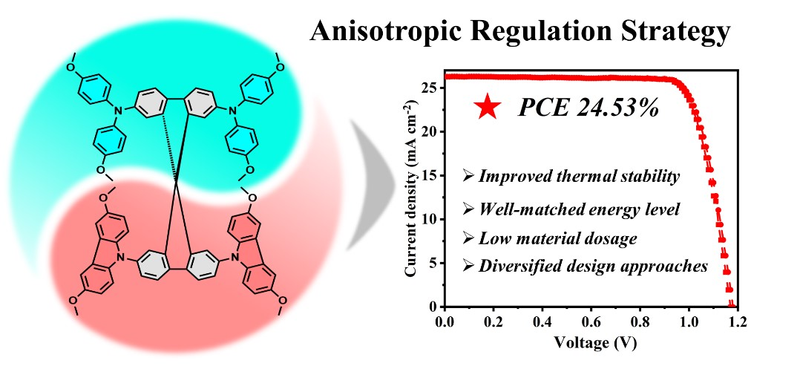Solution-processable perovskite solar cells (PSCs), with their significant advantages such as low preparation cost, short industrial production chains, and rapid increase in photoelectric conversion efficiency, are becoming a crucial direction for the next generation of photovoltaic technology. Currently, the hole transporting layers of high-performance perovskite cells are all based on the traditional spiro-type molecule, Spiro-OMeTAD, which features low intrinsic mobility, poor film-forming properties, and significant reduction in device stability due to the use of dopants. Therefore, the focus of current research in the field is on how to properly design hole-transporting materials (HTMs) with high hole mobility and superior thin-film morphology to produce efficient and stable PSCs.
Recently, using an anisotropic regulation strategy, Academician Huang Wei and Professor Wang Yang of Strait Institute of Flexible Electronics (SIFE, Future Technologies), Associate Professor Wei Dong of College of Physics and Energy, and Researcher Gao Peng of Fujian Institute of Research on the Structure of Matter (FJIRSM) of Chinese Academy of Sciences, designed and synthesized a novel spiro-type molecule, SF-MPA-MCz, featuring enhanced thermal stability and hole mobility, and more uniform and compact film morphology, when compared to Spiro-OMeTAD, which contribute to the formation of a hole transporting layer at the lower concentrations of SF-MPA-MCz solutions (~30 mg/ml) and a remarkable power conversion efficiency (PCE) of 24.53% for PSCs employing SF-MPA-MCz with long-term operational stability while maintaining a low synthesis cost. The work, titled “De novo Design of Spiro-type Hole-transporting Material: Anisotropic Regulation toward Efficient and Stable Perovskite Solar Cells,” has been published in the journal Research.
FNU is the first institution for completing the research, with Wang Xuran, a doctoral student of FNU, and Wang Mingliang, a master student of FNU, as the co-first authors of the paper, and Academician Huang Wei, Professor Wang Yang, Associate Professor Wei Dong and Researcher Gao Peng as the co-corresponding authors. The research was supported by the National Natural Science Foundation of China, and the Natural Science Foundation of Fujian Province.

(Translated by Xiao Zhiying/ Reviewed by Xie Xiujuan)
